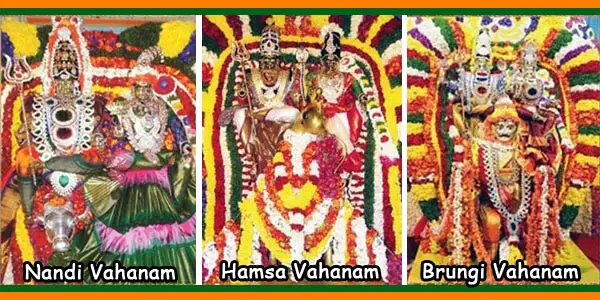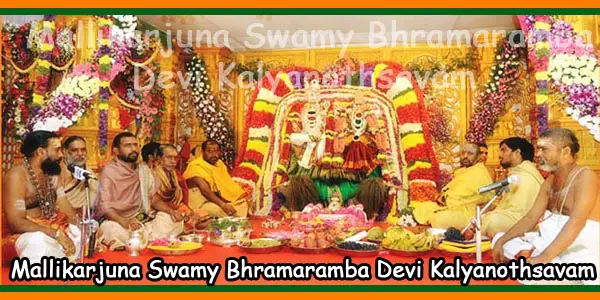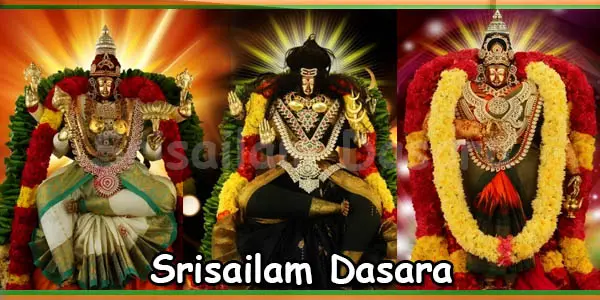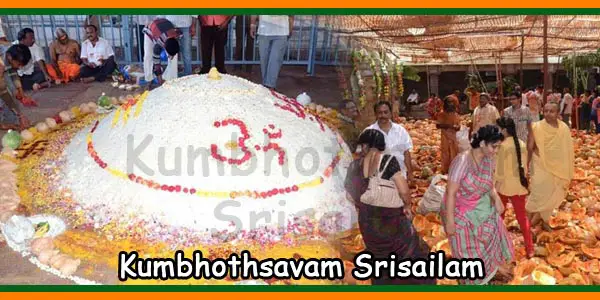Major Festivals:
Srisailam Mahashivratri Brahmotsavam:
The festival of Mahasivarathri Utsavam is celebrated as Brahmothsavam in the Lunar month Magham, which usually falls in the month of February/March.

Mahasivaratri is an eleven day festival with Navahaknika Deeksha. The Mahasivarathri day is celebrated on the 29th day of Magham, which is the most important day of the festival. The major events of the celebrations are Ankurarpana, Dhwajarohana, Vahana Sevas to God and Goddess, Lingodhbhavakala Maharudrabhishekam to God, Pagalankarana, Kalyanothsavam, Radhothsavam and Dhwajavarohana.

To begin the Brahmothsavam, a religious ritual called Ankurarpana is performed. It is followed by Dhwajarohana when a white flag, called Dhwaja Patam, marked with the image of Nandi, is hoisted on the Dhwajasthambha of the temple. Dhwajarohana is the important event that marks the beginning of Brahmothsavam by which all Gods and goddesses are invited for the festival.

Another significant event of the celebration is the Vahana Seva which involves procession Gods and Goddess on various ‘divine vehicles’ like Seshavahanam, Mayuravahanam, Nandivahanam and Aswavahanam.
At midnight of the Mahasivarathri day, during Lingodbhavakalam, which is the auspicious time when God Siva manifests in the form of huge flaming Linga, Abhishekas are performed to God Mallikarjuna Swamy in a religious manner.
The most significant event of the festival is Pagalankarana, which is a unique custom that can be found only in Srisailam temple. In this ritual, a person belonging to weaver’s community (Devanga) will tie a lengthy new white cloth known as ‘Paga’, beginning from the Sikhara of the Swayvari Vimana Gopuram and passing around the Nandi idols on the Mukhamandapam of the temple. The attractive feature of this event is that the Devanga decorates the Paga with naked body in total darkness and at that time all lights at the temple will be switched off.
Paga, the cloth used in the Pagalankarana, is hand woven by weavers throughout the year. About 30 Pagas are offered every year by various weavers individually as an oath and all the Pagas will be decorated by a single weaver.
Pagalankarana is followed by Kalyanothsavam of God Mallikarjuna Swamy and Goddess Bhramaramba Devi.

Radhothsavam (Car festival) is celebrated on the next day evening. It is estimated that over one Lakh devotees participate in the Car festival.
The Mahasivaratri celebration ends with Dhwajavarohana in which the Dhwaja Patakam (flag) is descended from the Dhwajasthambham.
Srisailam Ugadi Celebrations:
Ugadi, the Telugu New Year day, is an important festival celebrated for a period of five days. The celebration begins three days prior to the Ugadi day (Chaitra Suddha Padyami), which usually falls in the month of March / April. It is estimated that about five Lakhs of pilgrims, especially from Karnataka and Maharastra, visiting the temple during this festival.

The major events of the festival include Vahana Sevas of Gods and Goddesses, Alankaras of Goddess, Veerachara Vinyasalu and Car festival.
Several rituals including Punyahavachanam, Akhanda Sthapana, Mantaparadhana and Ankurarpana etc., are perfomed during the festival.
Different types of special pujas like Pratik Abhishekam to God, Navavaranarchana to Goddess, Rudrahomam and Chandihomam are performed every day.
Thousands of devotees from Karnataka and Maharastra visit the temple during these festivals by traveling the whole distance on foot. They present variety of offerings like tamarind, kumkum, saree, mangala sutram, flowers etc., to the Goddess Bhramaramba Devi. During their journey, the devotees carry Nandikavallu, which consist of Nandi images, on their shoulders and they offer pooja to them every day.
On the previous night of Ugadi day, a group of Kannada devotees called as Ganacharis, perform Agnigunda Pravesam (fire walking). They perform the practice called Veerachara Vinyasalu in which they pierce sharp weapons to their forehead, tongue, cheek, chin, and hands.
Different Alankaras offered to the Goddess include Mahalakshmi, Mahadurga, Mahasaraswathi, Rajarajeswari and Nijalankarana of Bhramaramba.
In the Vahana Sevas, the vehicles carrying Gods and Goddesses in procession are named as Bhringivahanam, Nandivahanam, Kailasavahanam, Ravana Vahanam and so on. The procession of Vahana Sevas and Alankaras takes place on every day evening hours.
During the evening hours of Ugadi day the Car festival is celebrated in a grand manner. About 3 Lakhs pilgrims visit the temple during this festival period.
Srisailam Dasara Celebrations:
The festival of Devi Sarannavaratrulu begins from the first day of the Lunar month Asweejam (September/October) and is celebrated for nine days. Special poojas are performed every day followed by major events like Chandiyagam, Rudrayagam, Navadurga alankaras to Goddess and Vahana Sevas to God and Goddess. Goddess Bhramaramba Devi is mainly worshiped during these festivals.
The festival begins with Ganapathi pooja, which is followed by the Kalasa Sthapana and ends with Poornahuthi.

Besides Yagams, several religious rituals are performed every day, which include Srichakrarchana, Navavarana pooja, Anustanams, and Devi Sapthasathi Parayanas. Kumari Pooja and Suhasini Pooja are also performed during evening hours. In the Kumari Pooja, young girls in the age group of 2 to 8 years are worshipped. In Suhasini Pooja, women whose husband is living (Soubhagyavati) are worshiped. Dampathi Pooja (worship of couple) is performed on Mahanavami day when pooja is offered to five couples. By the end of this day, offering are made to the Goddess as Satvikabali with sacrificial rice, breaking of pumpkins, coconuts etc.
After the celebration of nine days, on the tenth day of Dasara festival, Poornahuthi of Chandiyagam and Rudrayagam are performed during day time. In the evening Sami Pooja or the worship to Prosopia tree, is performed. It is believed that just by seeing the Sami pooja one can become victorious in all activities.
A variety of Navadurga Alankaras are offered to the utsava Vigraham of Goddess Bhramaramba. These alankaras include Saila Putri (Parvathi), Brahmacharini, Chandraghanta, Kushmandadurga, Skandamatha, Katyayini, Kalaratri, Mahagouri and Siddhidayini. Every day evening, special poojas are performed to these Alankaramurthies.
Various Vahana Sevas offered to the Gods and Goddesses are Bhringivahanam, Hamsavahanam, Ravana Vahanam, Kailasa Vahanam, Mayuravahanam, Nandivahanam, Seshavahanam, Gaja Vahanam and Aswavahanam.
The procession of the Vahanaseva and Alankaram are celebrated on a grand manner every day.
Srisailam Kumbhothsavams:
Kumbhothsavam is one of the most important festivals of the temple of Srisailam, which is celebrated on the first Tuesday or Friday, whichever comes earlier, after the full moon day of Chaitram, the first month of Hindu calendar. In this festival, various offerings are made to Goddess Bhramaramba Devi.

It is believed that on this day the Goddess is very violent and hence various poojas like Navavarana, Trisathi, Khadgamala etc., are performed in Ekantham or keeping the doors of Bhramaramba temple closed. The Archakas themselves perform the poojas and the usual darshanam to Goddess is not allowed at that time. In the evening, a man dressed like a woman comes to the temple and offers Mangala Harathi to the Goddess, which is called Kumbhaharathi. The doors of the temple are opened at that time. After performing Kumbha Harathi, the Goddess is covered with large quantity of Turmeric and Kumkuma. Then Satvika bali is performed. It is a ritual which involves offering the Goddess with Kumbham (cooked rice), pumpkins, large number of coconuts and more than 50 thousands of lemons, etc.
On this day, the local tribal people Chenchus perform tribal dances before the Goddess. Their significance is much more in the celebrations.
In the ancient days, there was a tradition called Vamachara Sampradayam in which human and animal sacrifices were practiced in the temple. Later on, the Advaitha Philosopher Adi Sankaracharya, who lived in 5th-6th century A.D., abolished the Vamachara Cult and established Dakshinachara cult, by which the Satvikabali became prevalent, offering Pumpkins, Coconuts etc.
Annabhishekam is performed to God Mallikarjuna Swamy in the afternoon of Kumbhothsavam day. After that, the deity is covered with curd rice and the temple doors are closed till the early hours of next day.
Srisailam Sankranti Utsavams:
Sankranti Utsavams are performed during the occasion of Makara Sankramanam in the Hindu month of Pushyam (January) and are celebrated for a period of seven days with Panchahnika Deeksha.
The celebrations begin with the Dhwajarohana and ends with the Dhwajavarohana. The festival is celebrated by performing various special rituals including Rudrahomam, Chandihhomam, Pushpotsavam, Brahmothsava Kalyanam, Sayanotsavam etc., besides the grand Vahana Sevas.
Srisailam Arudrothsavam:
Arudra is believed to be the birth Star of God Siva. In the month of Dhanu, on the day of Arudra Nakshatram, special poojas like Lingodhbhavakala Rudrabhishekam, Annabhishekam and Vahana Seva are performed to God Mallikarjuna Swamy.
Srisailam Karthika Mosothsvams:
Karthika month, which is the 8th month of Hindu calendar regarded as the most auspicious month. On Mondays, full moon days and other important days of this month a large number of lamps are lighted in the temple premises and houses, which is called Deepothsavam. On the full moon day of this month, Jwalathoranam (bonfire) is performed in temples. It is believed that by mere seeing this Jvalathoranam, one shall be relieved from all sins.
Large number of pilgrims, to the tune of 30000 to 40000, visit this temple during Kartheeka Masam, particularly during Sundays and Mondays.

Srisailam Sravana Mosothsvams:
These festivals are celebrated in the Hindu month of Sravanam (August/September) when several special poojas are offered to God and Goddess. The exclusive feature of this utsavam is the performance of Akhanda Sivanama Sankeerthana (Bhajana) which is performed round the clock throughout the month.
Monthly Festivals :
Besides the above the following Monthly and fortnight festivals are also being performed.
1) Masasivaratri: Mahanyasapurvaka Rudrabhishekam & Bilwarchana to Sri Swamy Varu (In the evening time)
2) Arudra Nakshtram: Mahanyasapurvaka Rudrabhishekam & Annabhishekam to Sri Swamy varu
3) Pournami (Full Moon Day): Laksha Kumkumarchana to Sri Ammavaru
4) Moola Nakshatram: Navavarana Puja to Sri Ammavaru
5) Sravana Nakshatram: Navavarana Puja to Sri Ammavaru
6) Suddha Chavithi Puja: Vrathakalpa Purvaka Shodashopachara Puja to Sri Ratnagarbha Ganapathi
7) Bahula Chavithi Puja: Vrathakalpa Purvaka Shodashopachara Puja to Sri Ratnagarbha Ganapathi.
8) Kruthika Nakshatram: Vrathakalpa Purvaka Shodashopachara Puja to Sri Kumara Swamy
